A few weeks before embarking on our first pandemic cruise, I researched our tour options. Even though COVID levels were under control in St. Kitts, San Juan, and St. Thomas, we did not feel comfortable sitting on a cruise ship tour bus or being part of a large group. Unlike many other passengers who felt safest aboard the ship, we wanted to explore St. Kitt’s historic sites, only reachable by car or bus.

I searched for a local expert on the St. Kitts Tourism website who offered private tours. After speaking with Russell Gregory III, we decided to reserve the Best of St. Kitts tour offered by St. Kitts/Nevis Luxury Taxis & Tours. At Port Zante, we were greeted by Chris James, a tour guide for St. Kitts/ Nevis Luxury Taxis & Tours.

Tour Guide Chris James
Inside his Cadillac Escalade, our sweaty bodies were cooled by the car’s air conditioning as James shared basic facts about St Kitts, and the neighboring island of Nevis, along with some information about the buildings in the Basseterre business district. Within a short period of time, we were outside the city limits and heading uphill when we learned that Chuck Norris’ movie, Missing in Action, was filmed on St. Kitts.
St. Kitts shares commonalities with neighboring Caribbean Islands—a history of slave trading, independence from a foreign entity, destructive hurricanes, an economy fueled by tourism, and significant repercussions from a lack of visitors due to the lingering pandemic.

Sandy and Ira at the fortress
Fairview Great House and Botanical Garden
To get a sampling of 18th century Caribbean plantation life, we visited the Fairview Great House. Our self-guided tour began in a spacious red room with white trim filled with replicas of colonial wooden furniture. Small signs offered glimpses of a past life when society found it acceptable for men to have concubines. Men would congregate in a study to smoke cigars, while women had their own parlor to sit and gossip.
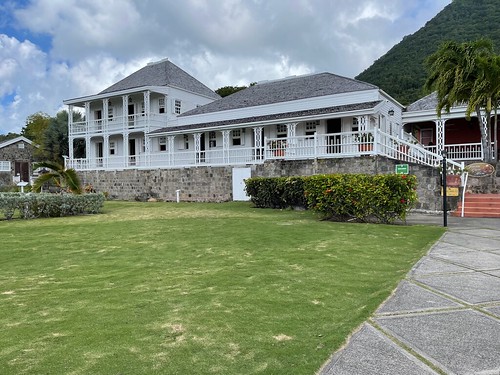
Fairview Great House
The steep wooden stairs led to a green and white master bedroom with a four-post bed. The magnificent views from the adjacent balcony highlighted the surrounding gardens and the distant coastline. We followed the designated route, which included additional rooms on the ground level. In one space, we found a timeline outlining the families associated with the property, and other signs offering tidbits of island history. We entered a room where the original five-foot-deep bath made from volcanic rock was the focal point, and then passed by the original kitchen.

5 foot deep bath at Fairview Great House
We did not have enough time to fully appreciate the Fairview Slavery Exhibit. Using detailed placards and a few artifacts, this small, recently opened museum introduces guests to the Transatlantic Slave journey, the transfer of the slaves in the Caribbean, to life in American plantations, and concludes with the emancipation and its aftermath. While I was aware of the role that the Europeans played in the slave industry, I did not know that African rivals sold slaves to the Europeans, nor was I aware that some slaves were criminals or were poorer individuals who were unable to pay their debts.

View from 2nd Floor balcony at Fairview Great House
The information outlined in this museum made us recall our previous visit to a couple of South Carolina plantations near Charleston. At those sites, we were reminded of the enormous number of slaves needed to run the profitable plantations. Now, our attention was focused on the individuals who ended up as slaves in the southern states. One poster asserted that it is “estimated that 20 million Africans were captured and enslaved. Over 1/3 died during the arduous journey by foot to the African west coast to board the slave ships for the transatlantic journey to the Americas. Another 1.8 million were estimated to have died during the passage.” While the exact numbers will never be known, this segment of world history should not be neglected. Sometimes we come across small museums in unlikely spots, recalling important points in history.

Fairview Slavery Exhibit
Romney Manor
Prior to the Carib Indian Massacre, these indigenous people resided in the area now known as Romney Manor. The European settlers referred to these Amerindians as Caribs, also known as Kalinaga Indians. Unlike the earlier Spanish settlers who received an inhospitable welcome to the island, the British, led by Thomas Warner in the 17th century, were warmly greeted.
Earlier in the tour, we visited Bloody Point where the river was reported to have remained bloody for three days after British and French soldiers murdered most of this indigenous population in 1626. Online sources claim that most of the remaining survivors left the island. A few historians hypothesize that the Europeans simply chose to murder the Caribs, while most websites claim that the soldiers were taking a preemptive strike against this group after being informed that the Caribs were planning to attack in the future. Without an indigenous population, the island’s population became a mix of Europeans and African slaves.
Near the Wingfield Estates, we captured images of 17th century Native American petroglyphs referred to as the Kalinago Rock Drawing. Petroglyphs on St. Kitts are believed to express the religious beliefs and practices of the indigenous people. These petroglyphs are a small reminder of a destroyed culture.
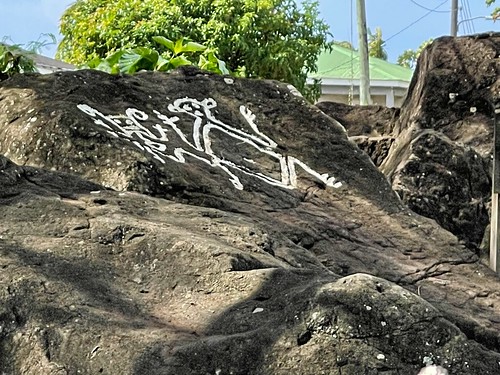
Kalinago Rock Drawing
Even though most tours identify our next destination as Romney Manor, Romney Manor and Wingfield Estate were originally referred to as the Red Plantation. Part of the original Wingfield Estate was sold to the Earl of Romney. He renamed it Romney Manor.
On our own, we explored a portion of the rolling terrain of the former Wingfield Estate, the first land grant by King Charles I in the Caribbean region. This 1,000-acre plot of land was granted to President Thomas Jefferson’s great, great, great, grandfather, Sam Jefferson. In the 17th century, this lush tropical area harvested tobacco and indigo crops. These products were subsequently replaced by the more profitable sugar cane industry along with a rum distillery.

Wingfield Estates pot still ruins
A handful of signs identified archeological remains representing the first examples of British masonry in the New World and the oldest remains of a distillery in the West Indies. When the plantation was operational, it used three methods to crush the sugar cane: animal power, water wheel power, and eventually steam engine power. When we passed by a riverbank, we came upon other ruins dating back to the indigo and tobacco days, as well as some tobacco trees.
While Ira and I were busy taking photos, I was approached by a man who boldly placed a small monkey on my shoulder. Without warning, the man reached for my phone and started taking pictures. When he was done, he insisted on being paid $10. I politely informed him that he did not have my permission to impede on my private space or to take pictures. Eventually, he departed with his monkey.

Sandy with monkey
To reach the main parking area, we walked a block or so where James was waiting in the car. James pointed out a 400-year-old Saman tree. The site’s large parking lot looked abandoned. It had only one parked white van. James told us that few cruise ship visitors are visiting the island’s major tourist attractions, and that many of the tour operators have gone out of business.
At our leisure, we admired the colorful and manicured gardens adjacent to the Caribelle Batik shop. Inside, we listened to a woman demonstrating the shop’s tie dye technique. We learned that authentic batiks are two sided and do not shrink. Items with a handful of colors take a few days, while more intricate designs require a couple of weeks to complete. The spacious shop sold a wide variety of wearable goods, as well as artwork.
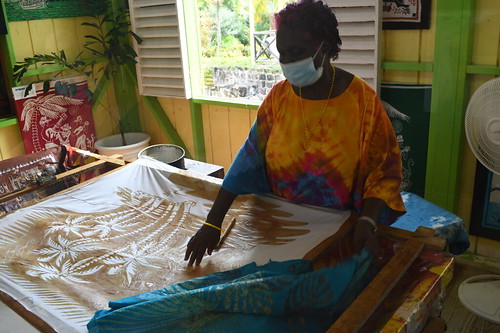
Batik Demonstration at Caribelle
Brimstone Hill Fortress National Park
A paved, narrow winding road leads to the Brimstone Hill Fortress, a UNESCO World Heritage Site. This impressive 800-foot structure with panoramic views of the surrounding area represents 17 and 18th century military architecture built by African slaves in a Caribbean location. Early on, the British understood the value of having a strategic stronghold. This structure took almost 100 years to complete construction. The French captured the fortress in 1782 and it was returned to the British after the signing of the Treaty of Versailles a year later. The British abandoned the fortress in 1852. In 1967, St. Kitts, Nevis, and Anguilla formed the Associated State of the United Kingdom. St. Kitts and Nevis became a two-island, independent state in 1983.
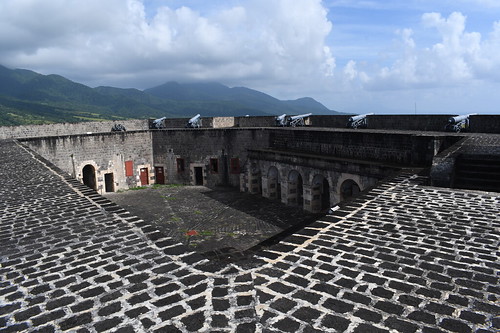
Citadel at Brimstone Hill Fortress National Park
After watching an outdated video, we climbed up the steep stone ramp to the Citadel, where abandoned cannons aimed outward. From this vantage point, we saw the multi-tiered adjacent military buildings, as well as the surrounding countryside, the coastline, and Nevis. We wandered in and out of the passageways, and eventually spent time in an antiquated museum with simple signage and graphics recounting the life of a soldier, the hardships of slavery, weaponry used by the soldiers, common diseases and illnesses, as well as general information pertaining to the origin of the island, the first inhabitants, the Atlantic Trade Routes, and the sugar cane and slave industry.

Cannons on Citadel at Brimstone Hill Fortress National Park
Even though the signage is decades old, this national park is a must see for anyone interested in historic sites with spectacular views.
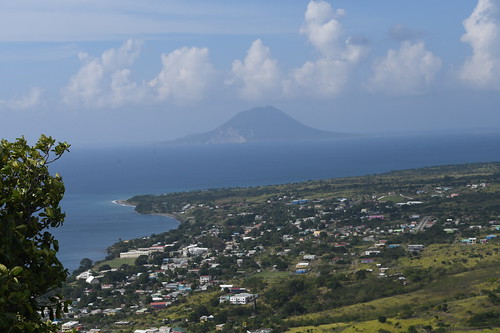
View from Brimstone Hill Fortress National Park
Unlike most of the passengers who chose to remain on the ship, we visited some of St. Kitt’s notable attractions. This engaging experience added to our understanding of how the Europeans eliminated the native population and subsequently implemented a profitable sugar plantation industry dependent on African slave labor. During our private tour, James made sure that we enjoyed our tour, and history came alive in St. Kitts.

Entrance to fortress
Sandy Bornstein, the History Comes Alive Through Travel Editor for Wandering Educators, has visited more than 40 countries and lived as an international teacher in Bangalore, India. Sandy’s award-winning book, May This Be the Best Year of Your Life, is a resource for people contemplating an expat lifestyle and living outside their comfort zone. Sandy writes about Jewish culture and history, historical sites, family, intergenerational, and active midlife adventures highlighting land and water experiences.
All photos courtesy and copyright Sandy Bornstein
